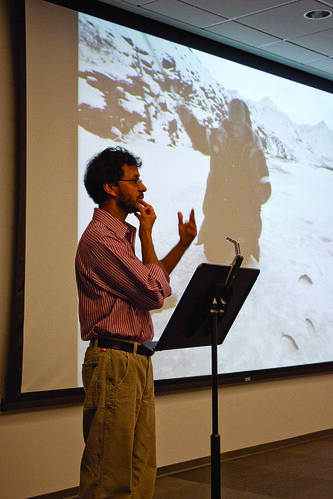Subhankar Banerjee, an art activist, spoke at the Tyler School of Art last Wednesday.
Art activism seemed to follow me everywhere this past week. My friend from the University of the Arts, a lecture at the Tyler School of Art and art class reminded me of the power to raise awareness through art.

Through my various encounters, I have come to the realization that this is quite possibly the crucial driving force for great artists today.
Last week my friend from UArts sent a mass e-mail that asked for help planning an event. Her idea was to showcase large-scale artwork with a bake sale to raise awareness about homelessness and starvation, with proceeds going toward a nonprofit, Broad Street Ministry. I was on board to help her any way I could.
“Using art to help others,” I thought. “Is there any better way to use one’s creative gifts nowadays?”
After discussing this collaboration with my friend, I attended a lecture hosted at Tyler by Subhankar Banerjee. Banerjee is a photographer known for his work on the nature and peoples of the Arctic. His photographs of polar bears and caribou migration patterns have been seen around the world and even used in Congressional debates over oil drilling in Alaska. Senator Barbara Boxer used Banerjee’s most famous photograph, which pictures a polar bear traveling across a glacier, in a debate during the Bush presidency. Banerjee’s photograph of migrating caribou, used in an ad about the destruction of oil spills in the Arctic, may very well have swayed some senators to vote against drilling in the early 2000s.
Banerjee’s lecture was both inspiring and intriguing. I asked him how he came about focusing on activism through photography, and he explained that it happened by accident and had much to do with the people who were viewing his work and their thoughts and feelings on his subject matter. He said he loves how his work is recognized now and would not change a thing about his journey to such a role. Although Banerjee’s original intent was not to raise awareness on issues like oil drilling, global warming and indigenous rights with his photographs, today’s audiences looking for such subjects in artwork is an amazing revelation.
I’ve also became aware of Tyler’s Guerrilla Altruism class, which focuses on using art and architecture to solve problematic issues like water runoff in the city and the destructive nature of bottled water. Like Banerjee, the students in this class are using art to make a difference.
The subject of art activism is fairly unique to the 20th and 21st centuries. Most conceptual art encompasses the idea of representing bigger issues, like politics, the environment or self-expression. Much of the art displayed at Tyler can be considered conceptual, with aspects of activism heading the creation of many of the displays. The pieces that are wowing audiences and inspiring young people to become artists use recycled materials or express pressing human rights issues. Sure, pre-20th-century art may have touched on these issues, but the use of found objects, recyclable materials and public placement is revolutionary to the mid-20th century and began prominently with artists from the Happenings movements to the Minimalism and Pop Art movements.
As an art historian, I sometimes forget this contemporary movement, and I concentrate on art in the past – artifacts revealing lost civilizations or paintings that explain historical events. In the past, I have criticized the loss of craftsmanship in contemporary art, the difficulty in understanding it and even its problematic nature for many viewers. But this idea of art becoming something more – something that circulates to raise difficult issues today and encourages the world to change – is something great.
In many ways, through speaking with my UArts friend, listening to Subhankar Banerjee and learning about students in the Guerrilla Altruism class, I realize the significant art of today circulates around aspects of activism – art that may not be necessarily aesthetically pleasing in the traditional sense, but pronounces the important issues of today.
Nicole Welk can be reached at nicole.welk@temple.edu.


Be the first to comment